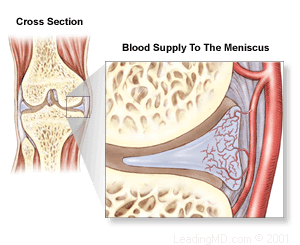Torn Meniscus Surgery in Indianapolis, IN and Mooresville, IN

Meniscus Injury


There are two categories of meniscal injuries:
- Acute tears usually occur suddenly when the knee is bent and forcefully twisted.
- Degenerative tears of the meniscus are more common in older people. As the meniscus ages, it weakens and becomes less elastic. Sixty percent of people over the age of 65 probably have a degenerative tear of the meniscus. Degenerative tears may result from minor events and there may or may not be any symptoms. In some circumstances, the arthritic joint (bone spurs / narrowing between the bones) can cause the meniscus to tear.
The location and type of the meniscus tear is very important in determining the best course of treatment. There are many different shapes and types of tears. Acute injuries tend to tear the meniscus with sharper edges. Degenerative tears are usually “complex”, meaning that the meniscus has several different patterns, often with frayed or worn down edges.

Non-operative treatment: in some cases, the treatments listed below can improve knee pain and function. These are often recommended for more degenerative tears.
- Rest/Activity modification—your doctor may suggest rest and activity modification, such as avoiding strenuous, high-impact activities like running and jumping. They may also recommend avoiding hyperflexion (knee bent past 90 degrees) activities, such as squatting, lunging and kneeling.
- Non-steroidal anti-inflammatory medicines—drugs like ibuprofen and naproxen reduce pain and swelling. Make sure to take the medication with food to prevent stomach problems. Also take medications with a full glass of water to prevent damage to the kidneys.
- Physical therapy— usually there is an initial focus on restoring normal motion to your knee. Stretching exercises to improve range of motion are very helpful. Once your pain is improving, your therapist can start you on a strengthening program for the supporting muscles that surround the knee.
- Steroid injection—if rest, medications, and physical therapy do not relieve your pain, an injection of a local anesthetic and cortisone may be helpful. Cortisone is a very effective anti-inflammatory medicine. The goal is to reduce the pain and swelling of the knee. This treatment is helpful in patients who want to avoid surgery and/or whose arthritis is too severe for an arthroscopic (minimally-invasive) surgical procedure.
Operative treatment: in many cases, especially acute tears, surgery for a torn meniscus can help restore function and reduce pain of the knee. There are several options when it comes to surgery for a torn meniscus, which are detailed in another information sheet.
Meniscus Surgery


Partial meniscectomy
This procedure involves removing only the torn piece of meniscus, but leaving the majority intact. Usually meniscectomy is used for tears located in the inner 2/3 of the meniscus where there is no blood supply. An analogy I like to use is that of a hang-nail. The torn meniscus can be thought of as the piece of nail that is torn away. The goal of surgery is to remove the torn part of the nail and leave the rest of the nail to function normally. If the meniscus remains mostly intact with only the inner portion removed, the patient usually does well and does not develop early arthritis.

Meniscal repair
Repairs are performed on tears near the outer 1/3 of the meniscus where a good blood supply exists, or on large tears that would require a near-total resection (removal). The torn portion of the meniscus is repaired by using either sutures or absorbable fixation devices. Most of the time this can be done arthroscopically without any added incisions. On rare occasions, a small incision may be made. Meniscal repairs are also often done with ACL reconstructions. If a meniscal repair is performed, you will be placed in a brace that prevents any unwanted bending of the knee.

Meniscal transplant
There are rare cases in which the meniscus is completely torn and unable to be repaired. Another scenario is if the patient has had previous surgery where the meniscus was almost completely removed. In younger patients with one of the above scenarios, surgery to “replace” the meniscus can be done. This uses an allograft (cadaver) meniscus and bone to restore the shock absorption of the knee. It is a complex procedure with about a 1 year recovery back to impact activity.
